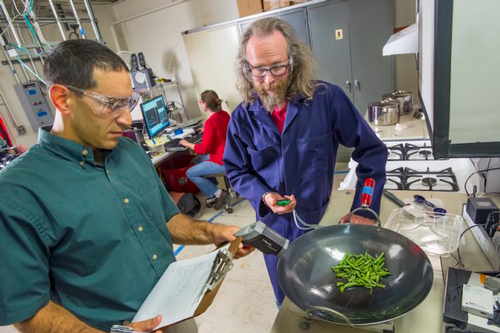Berkeley Lab Delves into Zero Net Energy
TUESDAY, JUNE 6, 2017
In an effort to help California meet its zero net energy goals, the Department of Energy’s Lawrence Berkeley National Laboratory—with $2 million in funding from the California Energy Commission—is backing a pair of new projects.
One study will provide detailed cost and performance modeling of ZNE homes; the other will explore how to ensure acceptable indoor air quality in ZNE homes that use natural gas.
California has set a policy goal that all homes constructed in 2020 or after must be energy-neutral, which means building houses with on-site generation or access to community green options.

 |
| Lawrence Berkeley National Laboratory |
|
The scientists at the Berklely lab have studied whether California's building code should be adjusted for improved health outcomes and energy savings; the code currently has a minimum airflow requirement for range hoods. |
“Getting to zero net energy will be a process,” said Berkeley Lab researcher Brett Singer, who is leading the air quality project. “These two projects will help the state with both its near-term ZNE goals as well as longer-term strategy.”
On the Right Path
The idea of ZNE buildings is to generate the same amount of energy that they consume annually. In California, carbon dioxide emissions from residential and commercial buildings make up about 23 percent of the state’s overall greenhouse gas emissions: about 14 percent are from electricity generation sources; 9 percent come from building heating fuels. The 23 percent ratio is the nation’s best.
An estimated 50 percent of existing buildings in California were built before the state’s Building Energy Efficiency Standards went into effect in 1978. The CEC says doubling the rate of energy savings from building-efficiency projects would lessen total building energy use in 2030—despite population and economic growth—when compared to 2014 data. Savings would be equivalent to a 17 percent reduction in usage when compared to projected 2030 levels.
“On the face of it, it seems like a quantum jump, but the state is preparing through existing standards, driving towards that objective,” said Max Wei, a Berkeley Lab researcher leading the second ZNE project.
Possible Solutions
Several steps are being considered to help California reach its ZNE goal:
- Reducing energy demand;
- Deploying on-site energy regeneration, often with solar panels;
- Forsaking natural gas and experimenting with all-electric homes; and
- Reducing kitchen pollutants, especially in homes equipped with gas-burner ovens.
The Berkeley lab established an indoor air team that has spent years analyzing how to make kitchens more energy efficient. Testing revealed many range hoods remove less than half of gas-burner pollutants.
The scientists have studied whether California's building code should be adjusted for improved health outcomes and energy savings; the code currently has a minimum airflow requirement for range hoods.
"It might be better to have a standard for capture efficiency rather than airflow," said Berkeley Lab researcher Rengie Chan.
Home Testing
Last year Southern California Gas, in cooperation with KB Home and Builder magazine, erected a demonstration home that integrated the most efficient gas and electric technologies.
While the model home unveiled technological advances that could help make ZNE homes a reality, SoCalGas surveys showed homeowners still prefer to maintain access to gas instead of strictly relying on electric, solar or other energy sources. Surveys showed that more than 80 percent of customers preferred dual-fuel homes, if given a choice.
Tagged categories: Building Envelope; Energy codes; Energy efficiency; Government; Lawrence Berkeley National Laboratory; Net Zero Energy ; Research; Residential Construction; Solar energy; U.S. Department of Energy


